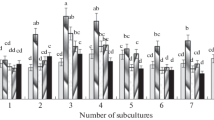Summary
Cultures ofDigitalis obscura L. were established from axillary buds of mature plants or leaves of seedlings obtained under aseptic conditions. Explants were cultured on Murashige and Skoog medium containing benzyladenine and/or naphthaleneacetic acid. Shoot proliferation from axillary buds was not affected by seasonal fluctuations in the stock plants and increased relative to the cytokinin concentration, but auxin reduced the multiplication rate. Differentiation of somatic embryos and adventitious buds from cultured leaves required naphthaleneacetic acid alone or combined with benzyladenine, respectively. Cardenolide pattern and content of the regenerated plants were determined by high performance liquid chromatography and radioimmunoassay, respectively. Several cardenolides of series A and C were identified in the regenerants; no significant differences were found in the cardenolide patterns. Digoxigenin derivatives were found in all clonally propagated plants, but the amount of these glycosides was much higher in those obtained from axillary buds. This is the first report on micropropagation ofD. obscura from mature plants.
Similar content being viewed by others
References
Arrillaga, I.; Brisa, M. C.; Segura, J. Somatic embryogenesis and plant regeneration from hypocotyl cultures ofDigitalis obscura L. J. Plant Physiol. 124:425–430; 1986.
Brisa, M. C.; Segura, J. Isolation, culture and plant regeneration from mesophyll protoplasts ofDigitalis obscura L. Physiol. Plant. 69:680–686; 1987.
Brisa, M. C.; Segura, J. Morphogenic potential of mechanically isolated single cells fromDigitalis obscura L. callus. Plant Cell Tissue Organ Cult. 19:129–139; 1989.
Brisa, M. C.; Pérez-Bermúdez, P.; Falcó, J. M., et al. Morphogenesis and cardenolide formation inDigitalis obscura cultures. J. Plant Physiol. 137:635–637; 1991.
Diettrich, B.; Mertinat, H.; Luckner, M. Formation ofDigitalis lanata clone lines by shoot tip culture. Planta Med. 56:53–58; 1990.
Erdei, I.; Kiss, Z.; Maliga, P. Rapid clonal multiplication ofDigitalis lanata in tissue culture. Plant Cell Rep. 1:34–35; 1981.
Herrera, M. T.; Cacho, M.; Corchete, M. P., et al. One step shoot tip multiplication and rooting ofDigitalis thapsi L. Plant Cell Tissue Organ Cult. 22:179–182; 1990.
Hildebrandt, V.; Harney, P. M. In vitro propagation ofSyringa vulgaris “Vesper”. HortScience 18:432–434; 1983.
Luckner, M.; Diettrich, B. Cardenolides. In: Constabel, F.; Vasil, I. K., eds. Cell culture and somatic cell genetics of plants, vol. 5. San Diego: Academic Press; 1988:193–212.
Murashige, T.; Skoog, F. A revised medium for rapid growth and bioassays with tobacco tissue cultures. Physiol. Plant. 15:473–497; 1962.
Pérez-Bermúdez, P.; Cornejo, M. J.; Segura, J. In vitro propagation ofDigitalis obscura L. Plant Sci. Lett. 30:77–82; 1983.
Pérez-Bermúdez, P.; Brisa, M. C.; Cornejo, M. J., et al. In vitro morphogenesis from excised leaf explants ofDigitalis obscura L. Plant Cell Rep. 3:8–9; 1984.
Pérez-Bermúdez, P.; Falcó, J. M.; Segura, J. Morphogenesis in root-tip meristem cultures ofDigitalis obscura. J. Plant Physiol. 130:87–91; 1987.
Robins, R. J.; Rhodes, M. J. C., editors. Manipulating secondary metabolism in culture. England: Cambridge University Press; 1988.
Rücker, W.Digitalis spp.: in vitro culture, regeneration, and the production of cardenolides and other secondary products. In: Bajaj, Y. P. S., ed. Biotechnology in agriculture and forestry, vol. 4. Berlin: Springer-Verlag; 1988:388–418.
Schöner, S.; Reinhard, E. Long-term cultivation ofDigitalis lanata clones propagated in vitro: cardenolide content of the regenerated plants. Planta Med. 52:478–481; 1986.
Weiler, E. W.; Zenk, M. H. Radioimmunoassay for the determination of digoxin and related compounds inDigitalis lanata. Phytochemistry 15:1537–1545; 1976.
Wichtl, M.; Wichtl-Bleier, W.; Mangkudidjojo, M. Hochleistungsflüssigkeits chromatografhische analyse vonDigitalis-blattextrakten. J. Chromatogr. 247:359–365; 1982.
Author information
Authors and Affiliations
Additional information
The financial support of CICYT, Madrid, Spain (project no. PB89-0419) is gratefully acknowledged.
Rights and permissions
About this article
Cite this article
Vela, S., Gavidia, I., Pérez-Bermúdez, P. et al. Micropropagation of juvenile and adultDigitalis obscura and cardenolide content of clonally propagated plants. In Vitro Cell Dev Biol - Plant 27, 143–146 (1991). https://doi.org/10.1007/BF02632198
Received:
Accepted:
Issue Date:
DOI: https://doi.org/10.1007/BF02632198




